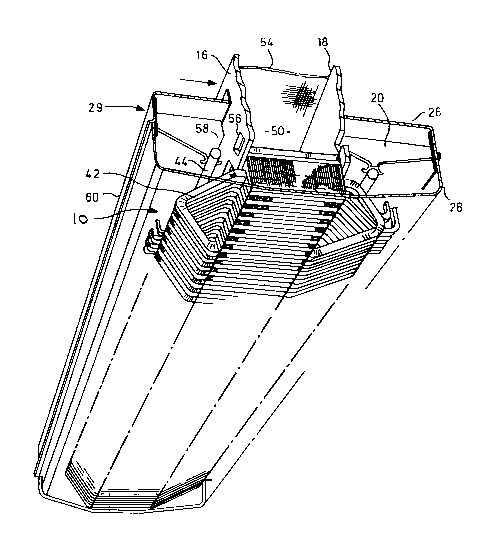Une partie des informations de ce site Web a été fournie par des sources externes. Le gouvernement du Canada n'assume aucune responsabilité concernant la précision, l'actualité ou la fiabilité des informations fournies par les sources externes. Les utilisateurs qui désirent employer cette information devraient consulter directement la source des informations. Le contenu fourni par les sources externes n'est pas assujetti aux exigences sur les langues officielles, la protection des renseignements personnels et l'accessibilité.
L'apparition de différences dans le texte et l'image des Revendications et de l'Abrégé dépend du moment auquel le document est publié. Les textes des Revendications et de l'Abrégé sont affichés :
| (12) Brevet: | (11) CA 2034277 |
|---|---|
| (54) Titre français: | CAISSON DE REFROIDISSEMENT DESTINE A UN MOTEUR ELECTRIQUE LINEAIRE |
| (54) Titre anglais: | COOLING STRUCTURE FOR LINEAR INDUCTION MOTOR |
| Statut: | Durée expirée - au-delà du délai suivant l'octroi |
| (51) Classification internationale des brevets (CIB): |
|
|---|---|
| (72) Inventeurs : |
|
| (73) Titulaires : |
|
| (71) Demandeurs : |
|
| (74) Agent: | MCCARTHY TETRAULT LLP |
| (74) Co-agent: | |
| (45) Délivré: | 1997-03-18 |
| (22) Date de dépôt: | 1991-01-16 |
| (41) Mise à la disponibilité du public: | 1992-07-17 |
| Requête d'examen: | 1991-08-23 |
| Licence disponible: | S.O. |
| Cédé au domaine public: | S.O. |
| (25) Langue des documents déposés: | Anglais |
| Traité de coopération en matière de brevets (PCT): | Non |
|---|
| (30) Données de priorité de la demande: | S.O. |
|---|
A primary of a linear induction motor has a plenum
formed on its upper surface to receive cooling air from a
fan. The upper surface of the core is formed with fins to
promote cooling. Air flows from the plenum to side housings
in which the end turns are located. A deflector plate
directs air from the plenum over the end turns of the
windings. Exhaust slots are provided in the housing above
the end turns and a baffle between the housing and the end
turns promotes flow through the end turns as it moves toward
the exhaust slots.
Note : Les revendications sont présentées dans la langue officielle dans laquelle elles ont été soumises.
Note : Les descriptions sont présentées dans la langue officielle dans laquelle elles ont été soumises.

2024-08-01 : Dans le cadre de la transition vers les Brevets de nouvelle génération (BNG), la base de données sur les brevets canadiens (BDBC) contient désormais un Historique d'événement plus détaillé, qui reproduit le Journal des événements de notre nouvelle solution interne.
Veuillez noter que les événements débutant par « Inactive : » se réfèrent à des événements qui ne sont plus utilisés dans notre nouvelle solution interne.
Pour une meilleure compréhension de l'état de la demande ou brevet qui figure sur cette page, la rubrique Mise en garde , et les descriptions de Brevet , Historique d'événement , Taxes périodiques et Historique des paiements devraient être consultées.
| Description | Date |
|---|---|
| Inactive : Périmé (brevet - nouvelle loi) | 2011-01-16 |
| Inactive : TME en retard traitée | 2010-01-22 |
| Lettre envoyée | 2010-01-18 |
| Inactive : TME en retard traitée | 2009-03-16 |
| Lettre envoyée | 2009-01-16 |
| Inactive : CIB de MCD | 2006-03-11 |
| Inactive : CIB de MCD | 2006-03-11 |
| Inactive : Regroupement d'agents | 2003-02-05 |
| Inactive : TME en retard traitée | 2001-02-02 |
| Accordé par délivrance | 1997-03-18 |
| Demande publiée (accessible au public) | 1992-07-17 |
| Exigences pour une requête d'examen - jugée conforme | 1991-08-23 |
| Toutes les exigences pour l'examen - jugée conforme | 1991-08-23 |
Il n'y a pas d'historique d'abandonnement
| Type de taxes | Anniversaire | Échéance | Date payée |
|---|---|---|---|
| TM (brevet, 7e anniv.) - générale | 1998-01-20 | 1997-12-17 | |
| TM (brevet, 8e anniv.) - générale | 1999-01-18 | 1999-01-12 | |
| TM (brevet, 9e anniv.) - générale | 2000-01-17 | 1999-12-16 | |
| TM (brevet, 10e anniv.) - générale | 2001-01-16 | 2001-02-02 | |
| Annulation de la péremption réputée | 2010-01-18 | 2001-02-02 | |
| TM (brevet, 11e anniv.) - générale | 2002-01-16 | 2002-01-11 | |
| TM (brevet, 12e anniv.) - générale | 2003-01-16 | 2002-12-17 | |
| TM (brevet, 13e anniv.) - générale | 2004-01-16 | 2003-12-23 | |
| TM (brevet, 14e anniv.) - générale | 2005-01-17 | 2004-12-22 | |
| TM (brevet, 15e anniv.) - générale | 2006-01-16 | 2005-12-23 | |
| TM (brevet, 16e anniv.) - générale | 2007-01-16 | 2006-12-19 | |
| TM (brevet, 17e anniv.) - générale | 2008-01-16 | 2008-01-11 | |
| TM (brevet, 18e anniv.) - générale | 2009-01-16 | 2009-03-16 | |
| Annulation de la péremption réputée | 2010-01-18 | 2009-03-16 | |
| TM (brevet, 19e anniv.) - générale | 2010-01-18 | 2010-01-22 | |
| Annulation de la péremption réputée | 2010-01-18 | 2010-01-22 |
Les titulaires actuels et antérieures au dossier sont affichés en ordre alphabétique.
| Titulaires actuels au dossier |
|---|
| BOMBARDIER INC. |
| Titulaires antérieures au dossier |
|---|
| DAVID GILMORE |
| JOHN STANNARD |
| KURT VOLLENWYDER |